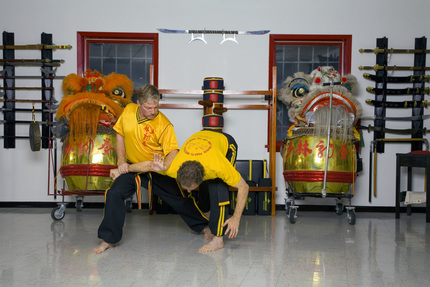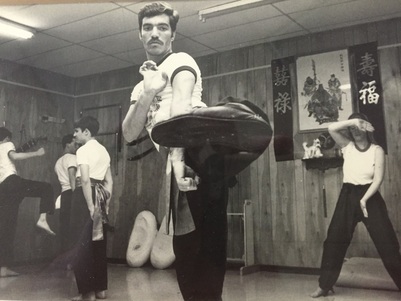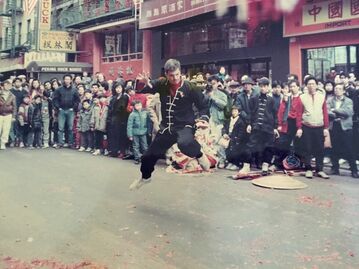|
Dragon Style
Many styles of Kung fu were created by watching or imitating the movements of animals, birds, insects, or by molding the system after the movements of nature, as in the Nature Fist Style. The Dragon Style, on the other hand, is the only style named after a mythical animal. Some people would argue that Chuka Shaolin or Phoenix Eye Fist Style would also be classified as being formed from a mythical animal. This would be true if one were looking only at the name. A Phoenix is a mythical animal or bird. However, the Phoenix Eye Style was not created from the mythical Phoenix, but from the White Crane Style of Kung fu, and a combination of praying mantis, tiger, monkey and snake styles. Therefore, Dragon is the only style created from a mythical animal. Since no one has seen a real dragon, how was the system created? The system is based on Chinese folklore, stories, and fables passed down from father to son. These then joined to become a style based on the way a dragon moved, stepped or roared. The dragon lived in the clouds or water, so thunder was the dragon “stepping,” and a tidal wave was the dragon “rolling over” and etc. The dragon was a serpent-like creature, which had four legs. Out of the five elements (earth, water, air, tire and metal), the dragon symbolized the earth and water. This would also mean hard and soft. The dragon’s movements were based on combining forces and opposites together. For example, hard — soft, straight line — circular, movement — non-movement, forwards — backwards, diagonal — twisting, up — down, left — right, head — tail, hand — legs, and internal — external. These were combined together to form a non-stop “attacking” force. Attacking could also mean intercepting or yielding to the opponent’s attack. The dragon of the West is usually characterized by a winged monster representing evil. To the Chinese, however, the Dragon was a fabulous creature, benevolent, life giving and worth of reverence. |
|
During the Celestial Empire (Chinese Dynasties), the dragon was the emblem of the imperial family. The “Son of Heaven” (the Emperor) was referred to as the “Dragon King” or Lung Wang. Imperial Dragons are always shown with five claws, whereas dragons representing “common” people were shown with four claws.
Dragons are represented as the protector of the land despite the fact that they also typified the destructive aspect of water, for example — Tidal Waves. In ancient China, the Dragon was a Yang force, associated with male fertility. The jade gem stone was thought to have come from the congealed semen of the dragon and being very lucky. Above all, the Dragon represented the fertilizing power of rain. His claws were the forks of lightning. The Dragon Stylist is both aggressive and defensive. Relying on offensive and defensive techniques applied to forward, backward and sideways movements. A Dragon Stylist will never “start” an attack, and would do everything possible to avoid an encounter. However, if a fight is unavoidable, then an absolute and totally determined effort is applied to overcome a potentially stronger force. Following an attacker’s first sign of aggression, a dragon stylist does not hold back, but becomes an instantaneous and non-stop attacking force relying on floating and sinking movements with shoulders dropped and elbows bent. |
 SiGung McCoy demonstrating a joint locking skill (chin na) on Sifu Mike from an article in a 2010 issue of Inside Kung fu Magazine.
SiGung McCoy demonstrating a joint locking skill (chin na) on Sifu Mike from an article in a 2010 issue of Inside Kung fu Magazine.
A Dragon stylist defends himself by withdrawing or curving his body inwardly to absorb or neutralize any incoming attack. When the opponent has over-reached in his or her attack, the dragon stylist changes from soft to hard, and combines footwork with blocks as he intercepts his or her opponent.
The Dragon stylist will evade the opponent’s attack, simultaneously intercepting and breaking through the defense of your adversary. You will take advantage of the tense side of the opponent’s attention, or the lax side of his or her inattentiveness. You will then launch a strike from an unexpected direction and strike an unexpected area.
As one arm strikes forward, the other is readied back. Your arms swing in and out with power generated from the waist. The application of pressure is in the same direction as the attacker’s force.
If the opponent moves forward, retreat and move along in the same direction as the attack. If he or she retreats, move forward into their retreating motion, and put the pressure back on again. Counter straight with curved, and curved with straight.
The Dragon stylist will evade the opponent’s attack, simultaneously intercepting and breaking through the defense of your adversary. You will take advantage of the tense side of the opponent’s attention, or the lax side of his or her inattentiveness. You will then launch a strike from an unexpected direction and strike an unexpected area.
As one arm strikes forward, the other is readied back. Your arms swing in and out with power generated from the waist. The application of pressure is in the same direction as the attacker’s force.
If the opponent moves forward, retreat and move along in the same direction as the attack. If he or she retreats, move forward into their retreating motion, and put the pressure back on again. Counter straight with curved, and curved with straight.
 SiGung McCoy demonstrating a side kick from the Northern Dragon Long Bridge 3rd Handset.
SiGung McCoy demonstrating a side kick from the Northern Dragon Long Bridge 3rd Handset.
Hands follow feet, feet follow hands. When the hands stop the feet follow, when the feet stop, the hands follow. Move left, go right, move right, go left. Up follows down, down follows up. A strike is a block, a block is a strike.
If the opponent’s power is too great, the Dragon stylist steps off line, to counter an opponent’s open area, and to “bounce” him or her out. The Dragon stylist, keeping the above in mind, uses many large zig — zag stepping movements with the practitioner constantly extending and contracting his or her body.
These concepts may seem hard to understand at first, but they will become more apparent with continued training in the Dragon style. These movements should be done together: up follows down, which could mean first strike up then drop low and strike. They could also be combined with the attacker’s movements. For example, if the attacker strikes up, drop low and counter-strike.
As with any history, over a period of time, information is lost or improperly transmitted. Dragon style is no exception. For example, although I have studied Dragon style for many years, I am still learning new things about it. In some instances, I have come across information about the Dragon Style which differs from information that I received earlier. Therefore, all students, even (especially) at the instructors level, are constantly learning or relearning information or techniques in the Dragon System.
If the opponent’s power is too great, the Dragon stylist steps off line, to counter an opponent’s open area, and to “bounce” him or her out. The Dragon stylist, keeping the above in mind, uses many large zig — zag stepping movements with the practitioner constantly extending and contracting his or her body.
These concepts may seem hard to understand at first, but they will become more apparent with continued training in the Dragon style. These movements should be done together: up follows down, which could mean first strike up then drop low and strike. They could also be combined with the attacker’s movements. For example, if the attacker strikes up, drop low and counter-strike.
As with any history, over a period of time, information is lost or improperly transmitted. Dragon style is no exception. For example, although I have studied Dragon style for many years, I am still learning new things about it. In some instances, I have come across information about the Dragon Style which differs from information that I received earlier. Therefore, all students, even (especially) at the instructors level, are constantly learning or relearning information or techniques in the Dragon System.

